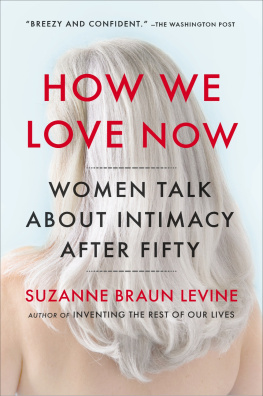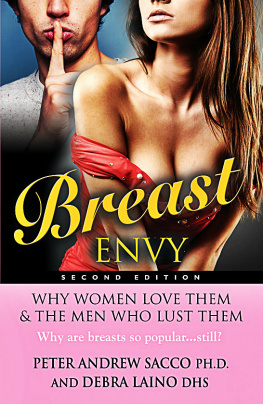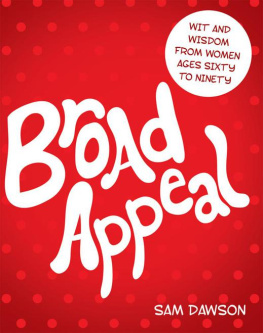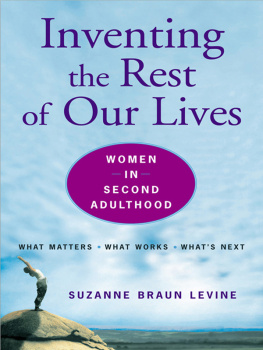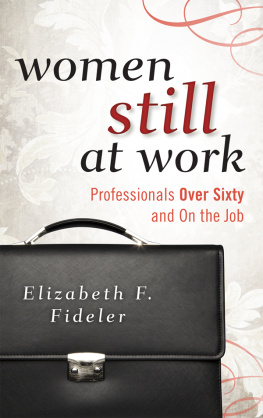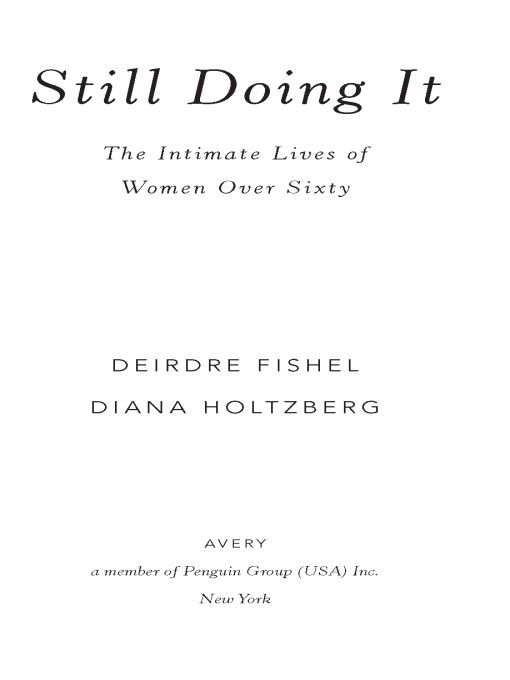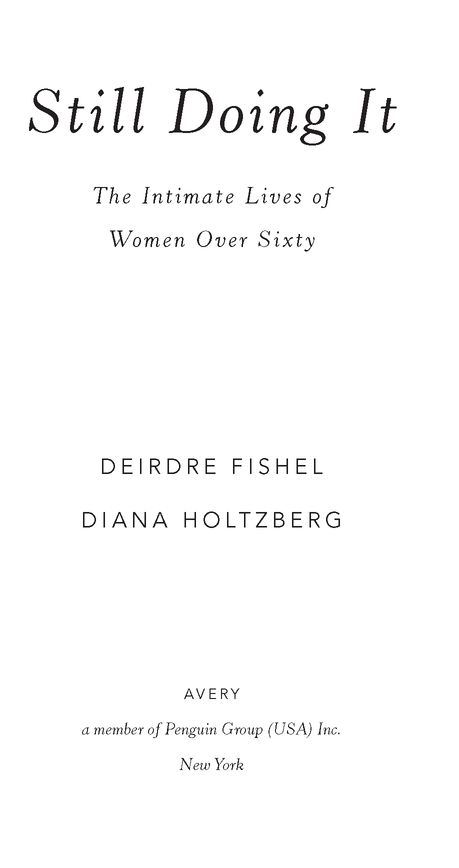Table of Contents
For our mothers, Irma Bellin Stevens and
Freddie Markowitz, not only for giving us life
but for being models of strong, independent-thinking
women. We honor them with our
enduring love. This book is for them.
ACKNOWLEDGMENTS
Wed like to thank our assistant, Nadia Anderson, who is wise beyond her years and whose dedication and skill were invaluable.
Wed also like to thank our agent, Peter Harrison McGuigan, a man in his thirties who got what we were trying to do and championed our cause.
In many ways we are just the conduit for the voices of the thirty-five women interviewed in this book. We want to thank each and every one of them for so fearlessly opening their hearts and sharing their lives with us.
Wed also like to recognize the handful of experts who generously shared their knowledge.
In addition, wed like to acknowledge our close friends and our sisters for their support and willingness to talk about the issues we were tackling during the long process of writing this. We couldnt have done it without them.
Finally, this book would never have happened had it not been preceded by our documentary film Still Doing It: The IntimateLives of Women Over 65. Wed like to thank all the people who helped make the film possible, including but not limited to Matthieu Borysevicz, our editor extraordinaire; Jan Rofekamp, Barbara Truyen, and John Nadai of Films Transit International, Inc.; Catherine Olsen, Charlotte Odele, and Diane Rotteau of the Canadian Broadcasting Corporation; Mette Hoffman Meyer of TV2 Denmark; the New York State Council on the Arts, for giving us an initial and crucial grant, and, all the broadcasters around the world and film festival programmers, too many to mention by name, who helped us launch the film.
INTRODUCTION BY DEIRDRE FISHEL
When the documentary Still Doing It came out, the question arose again and again whyat thirty-sevenhad I started a project about the intimate lives of women over sixty-five? The answer is simple. Thats the moment I got itthat aging, as a woman in America, is fraught with fearsome of it devoid of reality. I remember the summer. I was actually thirty-six, going on thirty-seven, and my sister, who is three years older than me, was turning forty. She was beautiful, had a compelling career, a great apartment, lots of friends. She lived in New York City, where shed grown up and wanted to live. But to hear her speak about her upcoming birthday was as if her life would soon be over. The source of her apprehension was obvious. Shed broken up with her boyfriend and as a single woman entering her forties she worried that her romantic/sexual life had already skipped town.
I was also single. And from that vantage point her fear was a little alarming. But it was also strange, somehow disconnected from her real life. True, she wanted children and her fertility was obviously diminishing. But the panic seemed all out of proportion. She was healthy and looked greatin fact, better than ever. And our own mother had met the love of her life at fifty-one, after two divorces.
So I started thinkingobsessing is probably a better wordabout what aging was really like for women. And if it were bad at forty, what would it be like at fifty, let alone sixty, seventy, or eighty? Right away, I realized that I had images of women over sixty who were smart and political like Nancy Pelosi and Ruth Bader Ginsburg. It seemed like you could even be creativethere was Joyce Carol Oates, Maya Angelou, and Ruby Dee. But what seemed disturbingly absent was exactly what troubled my sisterthe image that as an aging woman, especially, good God, a woman over sixty, you could still be juicy, sexysomeone that other people wanted toto put it bluntlyfuck.
Our mother, Freddie (featured in the film and in this book), had had a great sex life with her third husband, Sid, but tragically he died of cancer. Years later, she wasnt in a relationship. But still she was nothing like the sweet grandmother depicted in the media. She wasnt having sex, but at sixty-nine she sure as hell wished she were. What were other older women really like and what kind of lives were they having? Id heard rumors of women falling madly and passionately in love after sixty, and I became obsessed with finding them, as well as any other woman over sixty open to talking to me about her sexuality.
What I discovered, quite frankly, blew my mind. It wasnt just that I met churchgoing women who wanted sex but not marriage, women who couldnt keep their hands off each other, and women who were having two and three orgasms a night. It was the energy, the openness, and how frequently the word fun came up. While my friends were worrying about their children and careers, many of these older women were living it up. What started as a personal obsession became a mission to get a portrait of these women out into the world. And halfway into making the film, I had the good fortune to meet Diana Holtzberg, who was as excited as I was. As the executive producer of the documentary, she became another creative source and launched the film into the world. She also initiated the idea of writing this book.
My sisters story took a positive turn as well. She met her husband within a year and gave birth to a daughter four years later. But shes not alone in her dread of getting older and perceiving forty as old. The media routinely tout women in their forties and fifties that way. Yet the average life span of women is eighty, and if were old at forty then that means were at the end when were only halfway through. If we see ourselves as dried up at sixty, weve lost decades of our life.
What makes me outraged is that there is so much in this world thats often worse than the way its portrayed. War, poverty, early sexual experiences! But heres a situation where the reality is often so much better than what we imagine. In fact, many women I interviewed said age had given them the perspective to grab life by the horns. My decision, at forty, to become a single parent was inspired by knowing so many women over sixty who had met challenge after challenge and come out more passionate and alive.
Ive aged, however, since I began. At almost forty-seven, not only have I passed my thirties, but fifty looms in the not-so-distant future. And my awareness of ageism and an encroaching invisibility is no longer secondhand information. Ive felt the disconcerting feeling of being looked at in public less and less, of feeling somehow self-conscious about signs of aging. Still, overall, I feel more joy than I ever have.
And six months ago, as I had heard so many older women talk about, life brought a twist I couldnt have imagined. A fellow filmmaker, fourteen years my junior, called me. I had recently decided I wanted to be with women. She was smart, jaunty, impossibly attractive, but because of her age, my first thought was What does she want from me? As we spoke, I kept wondering when she was going to ask me to write her a recommendation or for the name of an editor, but she never did; and before we got off the phone we had a plan for Friday night. Stilldespite having met older women in relationships with people twenty, thirty, forty years youngerthe idea that this was a date never entered my mind!
Luckily for me, my own mental stereotypes surrounding age were pushed further open and we got together that night. But what Ive increasingly come to understand is that there are two parallel tracks occurring for many of us as we age: our true lives in juxtaposition to the cultural image. That disconnect begins around forty, and for many women over sixty that divide is massive. Despite the physical realities of aging, life after sixty (especially in those first two decades) can be intensely creative, sexually fulfilling, and wildly fun. Yet the media almost never choose to depict that.


